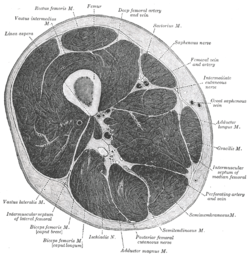Adductor longus muscle
A muscle of the thigh involved in adduction of the hip
Adductor Longus Muscle[edit]
The adductor longus muscle is a skeletal muscle located in the thigh. It is one of the muscles of the medial compartment of the thigh, primarily responsible for the adduction of the hip joint.
Anatomy[edit]
The adductor longus is a triangular muscle, which is the most anterior of the three adductor muscles of the thigh. It lies in the medial compartment of the thigh and is superficial to the adductor brevis and adductor magnus muscles.
Origin and Insertion[edit]
The adductor longus originates from the superior aspect of the pubis, below the pubic tubercle. It inserts into the middle third of the linea aspera of the femur.
Structure[edit]
The muscle is flat and thin, broadening as it descends. It is covered by the fascia lata and is bordered by the sartorius muscle laterally and the gracilis muscle medially.
Function[edit]
The primary function of the adductor longus is to adduct the thigh at the hip joint. It also assists in hip flexion and medial rotation of the thigh. This muscle plays a crucial role in stabilizing the pelvis during walking and running.
Innervation[edit]
The adductor longus is innervated by the obturator nerve, which arises from the lumbar plexus, specifically from the anterior divisions of the L2, L3, and L4 spinal nerves.
Blood Supply[edit]
The blood supply to the adductor longus is primarily from the obturator artery and the deep femoral artery.
Clinical Significance[edit]
The adductor longus is commonly involved in groin injuries, especially in athletes. Overuse or acute strain can lead to pain and dysfunction, often referred to as "groin pull." Treatment typically involves rest, physical therapy, and in some cases, surgical intervention.
Images[edit]


Related Pages[edit]
Ad. Transform your life with W8MD's Budget GLP-1 injections from $75


W8MD offers a medical weight loss program to lose weight in Philadelphia. Our physician-supervised medical weight loss provides:
- Weight loss injections in NYC (generic and brand names):
- Zepbound / Mounjaro, Wegovy / Ozempic, Saxenda
- Most insurances accepted or discounted self-pay rates. We will obtain insurance prior authorizations if needed.
- Generic GLP1 weight loss injections from $75 for the starting dose.
- Also offer prescription weight loss medications including Phentermine, Qsymia, Diethylpropion, Contrave etc.
NYC weight loss doctor appointmentsNYC weight loss doctor appointments
Start your NYC weight loss journey today at our NYC medical weight loss and Philadelphia medical weight loss clinics.
- Call 718-946-5500 to lose weight in NYC or for medical weight loss in Philadelphia 215-676-2334.
- Tags:NYC medical weight loss, Philadelphia lose weight Zepbound NYC, Budget GLP1 weight loss injections, Wegovy Philadelphia, Wegovy NYC, Philadelphia medical weight loss, Brookly weight loss and Wegovy NYC
|
WikiMD's Wellness Encyclopedia |
| Let Food Be Thy Medicine Medicine Thy Food - Hippocrates |
Medical Disclaimer: WikiMD is not a substitute for professional medical advice. The information on WikiMD is provided as an information resource only, may be incorrect, outdated or misleading, and is not to be used or relied on for any diagnostic or treatment purposes. Please consult your health care provider before making any healthcare decisions or for guidance about a specific medical condition. WikiMD expressly disclaims responsibility, and shall have no liability, for any damages, loss, injury, or liability whatsoever suffered as a result of your reliance on the information contained in this site. By visiting this site you agree to the foregoing terms and conditions, which may from time to time be changed or supplemented by WikiMD. If you do not agree to the foregoing terms and conditions, you should not enter or use this site. See full disclaimer.
Credits:Most images are courtesy of Wikimedia commons, and templates, categories Wikipedia, licensed under CC BY SA or similar.
Translate this page: - East Asian
中文,
日本,
한국어,
South Asian
हिन्दी,
தமிழ்,
తెలుగు,
Urdu,
ಕನ್ನಡ,
Southeast Asian
Indonesian,
Vietnamese,
Thai,
မြန်မာဘာသာ,
বাংলা
European
español,
Deutsch,
français,
Greek,
português do Brasil,
polski,
română,
русский,
Nederlands,
norsk,
svenska,
suomi,
Italian
Middle Eastern & African
عربى,
Turkish,
Persian,
Hebrew,
Afrikaans,
isiZulu,
Kiswahili,
Other
Bulgarian,
Hungarian,
Czech,
Swedish,
മലയാളം,
मराठी,
ਪੰਜਾਬੀ,
ગુજરાતી,
Portuguese,
Ukrainian